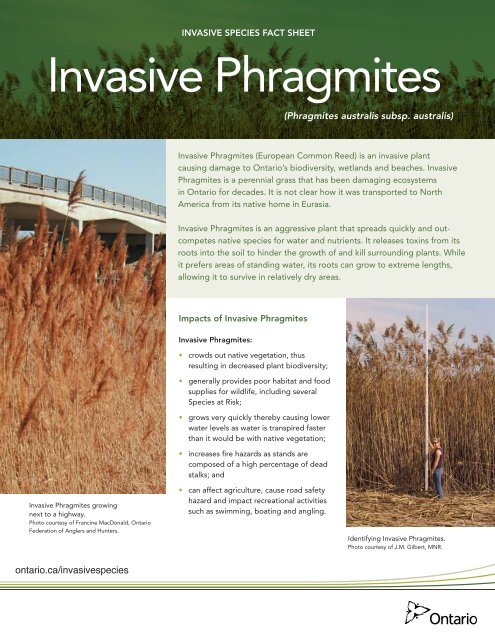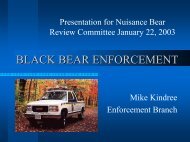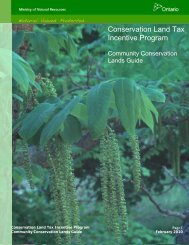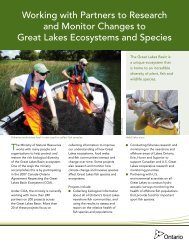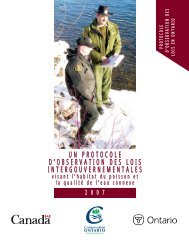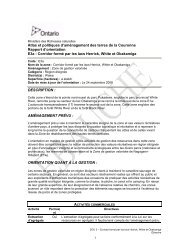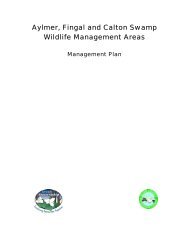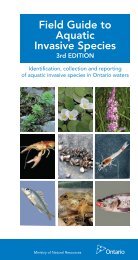Invasive Phragmites (Phragmites australis subsp ... - Ontario.ca
Invasive Phragmites (Phragmites australis subsp ... - Ontario.ca
Invasive Phragmites (Phragmites australis subsp ... - Ontario.ca
You also want an ePaper? Increase the reach of your titles
YUMPU automatically turns print PDFs into web optimized ePapers that Google loves.
<strong>Invasive</strong> Species Fact Sheet<br />
<strong>Invasive</strong> <strong>Phragmites</strong><br />
(<strong>Phragmites</strong> <strong>australis</strong> <strong>subsp</strong>. <strong>australis</strong>)<br />
<strong>Invasive</strong> <strong>Phragmites</strong> (European Common Reed) is an invasive plant<br />
<strong>ca</strong>using damage to <strong>Ontario</strong>’s biodiversity, wetlands and beaches. <strong>Invasive</strong><br />
<strong>Phragmites</strong> is a perennial grass that has been damaging ecosystems<br />
in <strong>Ontario</strong> for de<strong>ca</strong>des. It is not clear how it was transported to North<br />
Ameri<strong>ca</strong> from its native home in Eurasia.<br />
<strong>Invasive</strong> <strong>Phragmites</strong> is an aggressive plant that spreads quickly and outcompetes<br />
native species for water and nutrients. It releases toxins from its<br />
roots into the soil to hinder the growth of and kill surrounding plants. While<br />
it prefers areas of standing water, its roots <strong>ca</strong>n grow to extreme lengths,<br />
allowing it to survive in relatively dry areas.<br />
Impacts of <strong>Invasive</strong> <strong>Phragmites</strong><br />
<strong>Invasive</strong> <strong>Phragmites</strong>:<br />
• crowds out native vegetation, thus<br />
resulting in decreased plant biodiversity;<br />
• generally provides poor habitat and food<br />
supplies for wildlife, including several<br />
Species at Risk;<br />
• grows very quickly thereby <strong>ca</strong>using lower<br />
water levels as water is transpired faster<br />
than it would be with native vegetation;<br />
• increases fire hazards as stands are<br />
composed of a high percentage of dead<br />
stalks; and<br />
<strong>Invasive</strong> <strong>Phragmites</strong> growing<br />
next to a highway.<br />
Photo courtesy of Francine MacDonald, <strong>Ontario</strong><br />
Federation of Anglers and Hunters.<br />
• <strong>ca</strong>n affect agriculture, <strong>ca</strong>use road safety<br />
hazard and impact recreational activities<br />
such as swimming, boating and angling.<br />
Identifying <strong>Invasive</strong> <strong>Phragmites</strong>.<br />
Photo courtesy of J.M. Gilbert, MNR.<br />
ontario.<strong>ca</strong>/invasivespecies
invasive phragmites | 2<br />
A native <strong>Phragmites</strong> stand (left) and an invasive <strong>Phragmites</strong> stand<br />
(right). Note the varied vegetation and lower density of native<br />
<strong>Phragmites</strong> stalks on the left and the taller, higher density invasive<br />
<strong>Phragmites</strong> stalks on the right.<br />
Native stand photo courtesy of Erin Sanders, MNR. <strong>Invasive</strong> stand photo<br />
courtesy of Janice Gilbert, MNR.<br />
A native <strong>Phragmites</strong> seedhead (top) and an invasive <strong>Phragmites</strong><br />
seedhead (bottom). Note that the native <strong>Phragmites</strong> seedhead is<br />
smaller and sparser compared to that of the invasive <strong>Phragmites</strong>.<br />
Photo courtesy of Erin Sanders, MNR.<br />
Identifying <strong>Invasive</strong> <strong>Phragmites</strong><br />
One factor making the identifi<strong>ca</strong>tion of invasive <strong>Phragmites</strong><br />
difficult is the existence of a closely related native<br />
<strong>subsp</strong>ecies. Generally, native <strong>Phragmites</strong> does not grow as<br />
tall as the invasive plant and does not out-compete other<br />
native species. A number of characteristics of the plant <strong>ca</strong>n<br />
be useful in distinguishing between the native variety and<br />
invasive <strong>Phragmites</strong>. The following information <strong>ca</strong>n help in<br />
identifying invasive <strong>Phragmites</strong>.<br />
<strong>Invasive</strong> <strong>Phragmites</strong>:<br />
• grows in stands that <strong>ca</strong>n be extremely dense with as many<br />
as 200 stems per square metre;<br />
• <strong>ca</strong>n grow so densely that it crowds out other species;<br />
• <strong>ca</strong>n reach heights of up to 5 metres (15 feet), and<br />
• has stems that are tan or beige in colour with blue-green<br />
leaves and large, dense seedheads.<br />
Native <strong>Phragmites</strong>:<br />
• grows in stands that are usually not as dense as the<br />
invasive plant;<br />
• well-established stands are frequently mixed with other<br />
plants; and<br />
• usually has more reddish-brown stems, yellow-green<br />
leaves and smaller, sparser seedheads.<br />
What Can I Do?<br />
• Learn how to identify invasive <strong>Phragmites</strong> and how to<br />
avoid accidentally spreading it through its root fragments<br />
and seeds. This is especially important if you are planning<br />
to do work in an area which contains invasive <strong>Phragmites</strong>,<br />
• Do not plant invasive <strong>Phragmites</strong>. Native <strong>Phragmites</strong> have<br />
the same appearance and do not pose an ecologi<strong>ca</strong>l risk.<br />
• Gardeners should use only native or non-invasive plants<br />
and are encouraged to ask garden centres for plants that<br />
are not invasive.<br />
• Stay on designated trails. Leaving trails or entering areas<br />
containing invasive <strong>Phragmites</strong> <strong>ca</strong>n encourage the spread<br />
of this plant. When leaving an area containing invasive<br />
<strong>Phragmites</strong>, brush off clothing and clean equipment<br />
onsite to avoid the transfer of seeds to new areas.<br />
Remove all visible portions of plants and dispose them<br />
in the garbage.<br />
• Do not compost invasive <strong>Phragmites</strong>. Both seeds and<br />
rhizomes (horizontal plant stems growing underground)<br />
<strong>ca</strong>n survive and grow in compost.<br />
Other Resources<br />
www.ontarioinvasiveplants.<strong>ca</strong><br />
www.invadingspecies.com<br />
ontario.<strong>ca</strong>/invasivespecies<br />
For More Information:<br />
Contact the Invading Species Hotline at 1-800-563-7711.


